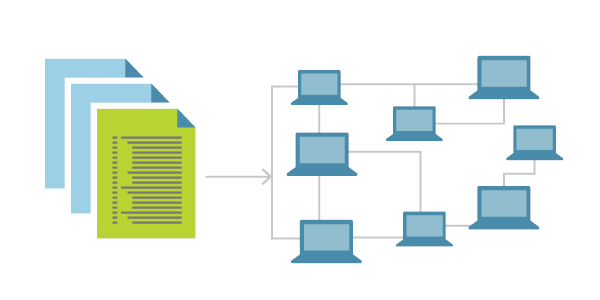What is Infrastructure as Code? (IaC)
Introduction: What is IaC?

Today we will become acquainted with a concept known as Infrastructure as Code. The idea of Infrastructure as Code is becoming more and more popular today. IaC is a method used to manage and provision a data center via defined machine-readable files instead of physical hardware configuration or other interactive configuration tools. This article will share what it is used for, why it is important, and why businesses strive to utilize this platform to achieve a desired set of results. It is essential to understand that we will consider both the theoretical and practical parts of IaC.
Pre-IaC
To understand why Infrastructure as Code emerged, we need to understand what came before IaC. In the classic server administration model, knowledge about server administration and structure looked like this.
- All expertise and solutions were left to the developers and system administrators. If an admin or developer left the company, administrative work could be delayed or diminished to the point of being business affecting, effectively halting many business processes.
- Most if not all information was stored on the servers themselves. Again, if a dev or admin could not address an issue with these servers, data could be lost.
- If every action and configuration is documented, that process could take longer than applying the actual changes. This documentation not only needs to be recorded but also kept up-to-date.
Infrastructure as Code (IaC)
Out of this situation arose a solution which could address many of these problems. With the advent of server documentation being translated into human-readable, maintainable, well-written code, IaC could be used to record updates and or modifications in it. Thus, we see the development of an Infrastructure as Code (IaC) solution. This platform describes the entire infrastructure, existing in code form, and the accompanying toolset needed for working with and translating it into a working infrastructure.
Because people are fallible, they cannot remember every change or modification made to a system. With this in mind, these processes' automation was noted to work better and faster than a person can. By automating these processes, a coded architecture will accomplish everything that an algorithm says it should do.
These are the types of algorithms used in this scenario.
- Declarative (functional) — describes what the problem is and the expected result.
- Imperative (procedural) — focused on what changes to make.
- Intelligent — explains why the infrastructure should be configured this way.
There are two main IaC methods used in these algorithms.
- Push — the management host sends configuration changes
- Pull — the primary host itself initializes the receipt of its configuration
Configuration Management vs. Configuration Orchestration
Configuration management includes tools like Chef, Puppet, Ansible, and Saltstack, which aid in the configuration of the software and systems within an existing infrastructure that has been provisioned already. Below are some of the most popular configuration management tools.
Tool | Released | Method | Approach | Written in |
2009 | Pull | Dec & Imperative | Ruby | |
Puppet | 2005 | Pull | Declarative | Ruby |
SaltStack | 2011 | Push & Pull | Dec & Imperative | Python |
2012 | Push | Dec & Imperative | Python |
Here is some information about the above tools.
- Chef is a configuration management system for automation and control of current processes.
- Puppet allows us to manage the OS and App configuration installed on multiple computers.
- SaltStack is a configuration management and remote execution system.
- Ansible is a system for describing and managing configurations.
Configuration orchestration tools, including such services as Terraform, Google Cloud Deployment Manager, and Azure Resource Manager, are designed to automate the deployment of servers and other infrastructure.
Tool | Released | Method | Approach | Written in |
| Google Cloud Deployment Manager | 2015 | Push | Declarative | Go |
| Terraform | 2014 | Push | Declarative | Go |
Azure Resource Manager | 2014 | Push | Declarative |
Here is some information about the above tools.
- Google Cloud Deployment Manager allows us to specify the resources needed for our application in a declarative format using yaml files
- Terraform is an open-source infrastructure as code software tool created by HashiCorp. Users define and provision data center infrastructure using a declarative configuration language known as HashiCorp Configuration Language (HCL), or optionally JSON
- Azure Resource Manager is a Microsoft tool used for the deployment and management of Azure services
In addition to system administrators, IaC is also used in DevOps practices and SRE specializations. DevOps and SRE or Site Reliability Engineer are also popular methodologies. Most situations from different areas grow into DevOps and SRE. Systems engineers and administrators grow into DevOps while developers grow into SRE. This is not always the case, but they are the most popular versions. It is essential to understand this because we will use examples from these related areas. Now let's consider what problems we will face using IaC.
IaC Problems
Diversity of Systems
Let's say we have a well-defined infrastructure written with high-quality documentation. The first problem is that in many IaC situations, DSL or domain-specific language comes into play. DSL is a description of the language used in each application. Most such depictions use the well-established markup languages like YAML or JSON, with which many have long existed and know how to work with. Most companies are expanding the ability to use other markups, but some companies use their own markup languages or their structure descriptions or modifications.
For each program in which you want to use your DSL, you need to understand how to explain, work with this description, debug it, and look for errors. For example, there are no such familiar objects in programming languages.
- Variables
- Conditions of implementation
- Comments function (in json format, they are absent and not provided for)
- Also, high-level objects like classes, OOP, and so on.
Fortunately, most of these current programs are developing more and more while trying to solve these problems.
Diversity of Technologies
The next dilemma is that we do not have a single ecosystem or technology stack to work from. There is a wide variety associated with different technologies. Let us take a look at the developers' side of this issue. Developers tend to be more familiar with IaC since they write most of the code that is used in an IaC environment. If a developer writes in C#, the infrastructure associated with this programming language will be used there. The technology stack will be interconnected with the language. Unfortunately, it is not that simple with IaC yet.
Recently, we came across a real-world example. A Python script initiated a process. This process generated a JSON page and dropped it into an analyzer. The analyzer then broke that down into 30 files which fed into a Go program. The variables in Go passed that output through the yaml file. Which, as a result, a file with the jsonnet extension was produced, which needed to be converted to json again and sent through a type of app API. In addition to the fact that this is difficult to describe in the structure of the IaC, it is even more complicated to look for the cause of a problem and debug it in such a system.
Diversity of Functions
For programmers, the development of an application is carried out within one task framework in mind. This is associated with one language, tied with one stack and technology. Immediately, it can become complicated to achieve this. While these are issues, these are not the most immediate problems seen. We can say goodbye to such aspects as:
- Auto completion
- Refactoring tools
- Debugging
- Detecting errors at startup or compilation
Although this is all used for the most part by developers, it is designed to make it easier to write code. We typically describe our infrastructure in code. These are not essential aspects, yet it increases the time spent developing and writing code and finding errors that inevitably appear. We don't need to think about how to adequately describe the infrastructure, design the system, write readable code, and so on. Now we need to think about how to write code and commands correctly and syntactically. There are all sorts of unique IDEs that provide help and suggestions in the world of development for beginners.
IaC Testing
Some will say that these concerns are not serious. For example, some tests are specifically created for IaC, and these tests eliminate many problems and errors, but they are not perfect. It is typically best to describe the goals in the language in which the program itself is written. Because IaC is a new platform, there are not many tests and testing tools in general. Currently, there is a lack of proven tests for IaC, which can be a weak point.

With this in mind, we took two popular instruments (namely Java and Terraform) and compared them in terms of maturity. In comparing, say, the Java language platform, there are a significant number of methods used to test. Because IaC takes many of its queues from programming, in essence, we are designing an application framework using the same thought process. Therefore, we used java as an example of one of the most popular programming languages and terraform on the IaC side as it is a popular IaC program.
Best Practice
There are many best practices in Java, but because Terraform is new, there are fewer defined best practices. We used java to compare because IaC involves coding within a structure. And since terraform is one of the most popular programs used for infrastructure description, the

Is This a Negative?
Not really! The level of knowledge continues to grow quite fast. Experts and reports in this area appear often, but this is just the beginning of the technology. There will continue to be evolutions that will pick up and build on those earlier developments. Do not forget that we can successfully implement the methods and practices in other areas as well. There are still many nuances and details which will continue for a long time to come. More importantly, we implement IaC because it solves many of the larger problems that existed previously.
Conclusion
In this tutorial, we reviewed IaC how we came to use IaC. We examined why many decide to use IaC and how it arose. We also considered from a different point of view what problems we got using IaC. We did this because IaC is not a solution to many issues, but another approach that solves problems, but has with you. Since this trend is relatively new, you may be the one who will be able to contribute to it in the future!
Learn More!
Related Articles:

About the Author: Margaret Fitzgerald
Margaret Fitzgerald previously wrote for Liquid Web.
Our Sales and Support teams are available 24 hours by phone or e-mail to assist.
Latest Articles
How to use kill commands in Linux
Read ArticleChange cPanel password from WebHost Manager (WHM)
Read ArticleChange cPanel password from WebHost Manager (WHM)
Read ArticleChange cPanel password from WebHost Manager (WHM)
Read ArticleChange the root password in WebHost Manager (WHM)
Read Article


